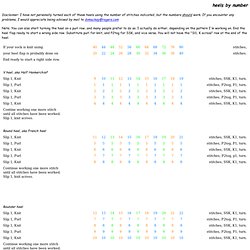

Heels by Number. Heels by number Disclaimer: I have not personally turned each of these heels using the number of stitches indicated, but the numbers should work.

If you encounter any problems, I would appreciate being advised by mail to dvmackay@rogers.com Note: You can also start turning the heel on a purl row, and many people prefer to do so. I actually do either, depending on the pattern I'm working on. End the heel flap ready to start a wrong side row. The math involved in these heels is not hard once you understand how the heel is shaped: V heel - work across half the heel flap, decrease, work one stitch and turn; work one stitch, decrease, work one stitch and turn; work to gap, decrease, turn, etc. Round heel - work across half the heel flap plus two stitches, decrease, work one stitch and turn; work five stitches, decrease, work one stitch and turn; work to gap, decrease,turn, etc. Acknowledgements: I must also thank Holly Doyne for patiently taking the time to explain the Band heel for me - twice. Foot Size Chart. The following measurements are for crew-style or dress socks, which usually come several inches above the ankle and below the calf. 11a.

Foot Circumference: To determine the foot circumference, measure around the widest part of your foot. 11b. Sock Height: To determine the height of the sock, measure from where you start to turn for the heel shaping to the top of the sock. 11c. NOTE ABOUT SOCK SIZING: In our charts we only refer to U.S. sizes and in the U.S. sock size ranges overlap. NOTE ABOUT PRINTING THIS CHART: While easy to read on your computer screen, the above chart will be slightly bit mapped when printed.
Return to top. Generic Toe-up Sock Pattern. Size: women's medium (large) Note: You can adjust this pattern for any size, any gauge.

Measure around the ball of your foot. Multiply the number of inches you get by the number of stitches you get per inch when you do a gauge swatch. Then subtract 10% from that total. Fudge your number so it’s divisible by 4. Gauge: 8st/inch -- I use US size 0 (2mm) needles with sock yarn. Start Your Toe Using a provisional cast-on, cast on 30 (32) stitches (half the total circumference of the sock). Using waste yarn, crochet a chain that is several chain stitches longer than the number of knit stitches you need. Row 1: Knit 29 (31) stitches. Row 2: Slip the first, unworked, stitch from the left needle to the right needle. Row 3: Slip the first stitch and knit across to the last stitch before the unworked stitch. Row 4: Slip the first stitch and purl across to the stitch before the unworked stitch.
Now you'll work the second half of the toe: Wrap the next stitch (so that it now has two wraps) and turn. Foot Sizing Survey Results; Contest! Last year, I ran an email survey: I asked knitters to measure the feet of their friends and family, asking for the following data: I got nearly 400 replies, providing meaningful data for foot lengths 8.5-11 inches, foot circumferences 8 to 11 inches.

Disclaimer: although I received replies from all over the world, most of the data I received was from North American knitters. I received more data for women’s feet than men’s. There is inherent risk in getting respondents to take their own measurements: I have to trust that they measured in the right place. I don’t claim that this represents every foot in the world, and I don’t believe it should be taken as the final answer on foot size. Note: when I mention foot circumference, I mean around the ball of the foot.
I found some interesting results – some confirming what we felt we knew, as sock knitters, others rather surprising. -In the vast majority of cases, ankle circumference is the same as the foot circumference. If you have foot length: